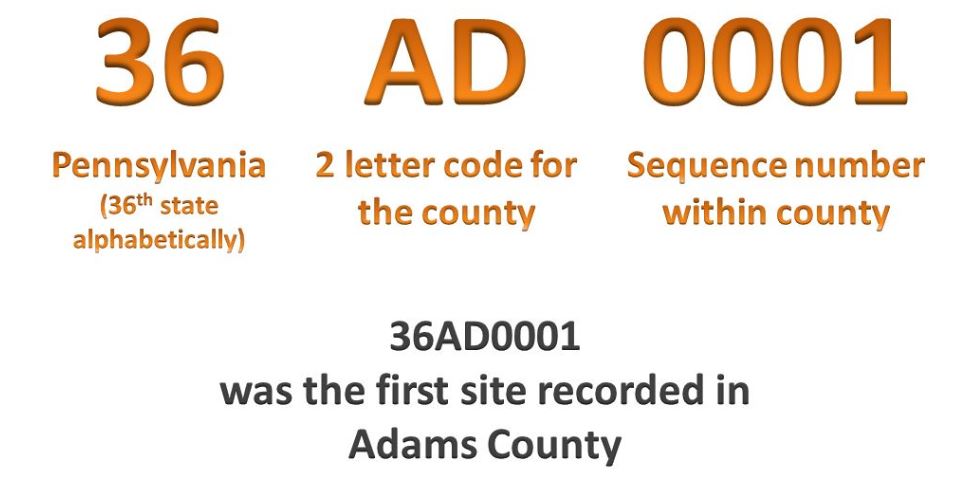Recording Sites
The Pennsylvania Archaeological Site Survey (PASS) form is used to record archaeological sites in the state of Pennsylvania. You should attempt to complete as much information on the form as possible. (Cultural Resource management projects must fill the entire form or it will be returned). View the PASS Form Help file below if you need assistance. If you have any further questions, you may contact the Bureau for Historic Preservation at RA-CRGIS@pa.gov or by phone 717.214.6572.
- PASS form (DOT) - Pennsylvania Archaeological Site Survey form in Microsoft Word Document format.
- PASS form (PDF) - Pennsylvania Archaeological Site Survey form in Adobe PDF format
- PASS form help (PDF) - Helpful information about how to fill out the PASS form.
Anatomy of a Site Number
Most states in the United States (including Pennsylvania) use the Smithsonian's trinomial system for numbering archaeological sites. These site designations are comprised of three parts: a state identification number, a two-letter code identifying the county in which the site is located, and a sequential site number within that county.
State identification numbers were established by alphabetical order in the 1940s. At that time, Pennsylvania was the 36th state by alphabetical order; therefore, all archaeological site designations in Pennsylvania begin with the number 36.
The county code, a two-letter designation, is representative of the specific county in which a site is located. Each county has a unique county code.
The final part of the trinomial site designation is the site number which corresponds to a specific site within a county. These numbers are assigned in sequential order once a PASS form is received, and it has been determined that the resource is an archaeological site based upon site identification criteria, and that the site has not been previously recorded.
For example, site number 36Ad0001 represents the first site (0001) recorded within Adams County (Ad) in Pennsylvania (36). Download the complete list of Pennsylvania's county codes (CSV).

Frequently Asked Questions about Recording sites
Q. How do I know if what I found is an archaeological site?
A. Read our Site Identification Criteria (PDF).
Q. If I record this site, will the State stop me from developing my land?
A. No. The role of the State Historic Preservation office is to advise agencies on projects that involve state or federal money and permits. It cannot stop private land owners from developing on their own land.
Q. Once I record this site, won't everyone be able to find it and dig it up?
A. No. Site locations are protected information and are not available to the general public. In addition, the Bureau for Historic Preservation keeps all land owner information confidential in the site files.
Q. I have all these artifacts from my site, what do I do with them now?
A. Read the State Museum of Pennslyvania's Curation Guidelines (PDF) to learn the proper way to care for artifacts.
Q. Can I collect artifacts from any site I want?
A. Not necessarily. Remember, if sites are on private land, you need the landowners permission before you can visit that site. Also, it is a criminal offense to collect artifacts from State or Federal land.
Q. I have a site that I want to dig. How do I conduct an archaeological dig?
A. First, if the site is not on your land, make sure you have permission. Next, we suggest contacting a professional or an experience advocational archaeologist who can show you the proper methods. A good place to look is to contact local universities and colleges or your local Society for Pennsylvania chapter Remember that one of the most important things about digging at an archaeological site is collecting the information as you dig. Archaeology is a destructive science. Once the site is gone, if proper notes weren't taken, the information will be lost forever. It is important to keep detailed records of what was found and where you found it. If you want to know how professionals are required to conduct digs under project review laws, visit our Guidelines for Archaeological Investigations (PDF, 244 KB).
Q. Where can I view information about sites in Pennsylvania?
A. Everyone can access archaeological site information online from the Cultural Resources Geographic Information System (CRGIS). Public users can get detailed information about the sites and what was found there. Remember, locations are a protected detail, so only qualified professionals will be able to map the sites. For more information, visit the CRGIS website.
Resources to Help Record Sites
- SoilMap - SoilMap provides free and convenient online access to detailed soils information for all of Pennsylvania.
- Landforms of Pennsylvania - From Map 13, Physiographic Provinces of Pennsylvania
- Atlas of Preliminary Geologic Quadrangle Maps of Pennsylvania - DCNR site with 623 out-of-print Geologic quadrangle maps for Pennsylvania
- Pennsylvania Spatial Data Access(PASDA) - GIS data for Pennsylvania
- Society for Pennsylvania Archaeology - Resource for information on how to fill out the PASS form
- Maryland Guide to Archaeology Resources - Avocational Archeologists Guide to Information Resources
- What's the Point? - Resource site on identifying diagnostic stone projectile points of Ohio